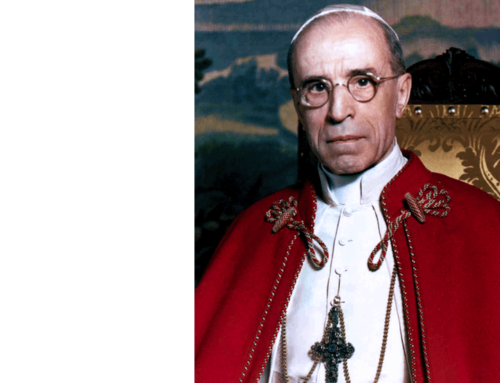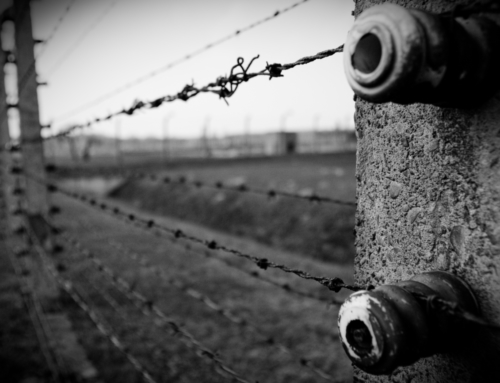| Ronald J. Rychlak
Catalyst, March 2007 Eugenio Pacelli became Pope Pius XII in 1939, after having spent nine years as Cardinal Secretary of State. Prior to that, he had been the Vatican’s representative in Germany. During his lifetime, Pius XII’s opposition to Hitler was well known. Nazis condemned him, Jews thanked him, and rescuers identified him as their inspiration. More recently, however, some writers have raised questions about how actively he opposed the Nazis. One even dubbed him “Hitler’s Pope.” Critics often claim that the Vatican is hiding evidence of the Pope’s activities during the Holocaust because, like most nations, the Holy See keeps diplomatic records sealed for a number of years. This respects the confidentiality of people who are still living, protects state secrets, and gives archivists time to index and catalog documents. The Vatican has, however, tried to accommodate the researchers. In the 1960s, Pope Paul VI appointed a team of four Jesuits to cull through the archives for relevant documents from the Holocaust era. By 1980, they had produced and made public 11 thick volumes of documents. This did not satisfy the critics, because the actual archives containing post-1922 documents remained closed to outsiders. In 2003, some archives from the years 1922-1939 were opened, and in 2006 more were opened. These archives cover the years during which the Nazis came to power and during which the future Pope Pius XII was very involved in German-Vatican diplomacy. Even though these archives (not to mention the 11 volumes prepared by the Jesuits) have not been fully mined, many researches, some with personal agendas, continue to clamor for more access. Recently, 35 such researchers petitioned the Vatican to open all Holocaust-era archives. One of the petitioners, Seymour Reich, wrote to Jewish Week complaining that the beatification of Pius XII before all archives were open would cause “serious problems with the Jewish community’s attitude toward the Vatican.” One wonders whether these petitioners are aware of the new archival evidence. One piece of recently discovered evidence is a letter written in 1923, when Hitler was just emerging as a force within Germany, in which papal representative Pacelli reports that “followers of Hitler” are persecuting Jews and Catholics. The future Pope refers negatively to this group (not yet known as Nazis) as “right-wing radicals.” He also praises the “learned and zealous” Cardinal Archbishop Michael Faulhaber of Munich whom the radicals attacked because he “had denounced the persecutions against the Jews.” It had long been known that philosopher Edith Stein (recently canonized as St. Teresa Benedicta of the Cross) wrote to Pope Pius XI in 1933 concerning the Nazis and their treatment of Jews. The precise words she used, however, were not known. It had been assumed that she asked for an encyclical—a formal papal document—condemning Naziism. It turns out there was no such request. The reply letter to Stein, which was not seen until the new archives were opened, came from Secretary of State Pacelli. The future Pius XII assured Stein that the Vatican shared her concerns and that the Church would ultimately score a “final victory” over Nazism. The newly opened archives also show that even before Stein sent her letter to Rome, the Vatican had instructed its representative in Berlin to intervene with the German government on behalf of the Jews. Upon reviewing these documents, CNN’s Vatican correspondent concluded that its release “resolves a historical debate in favor of the Vatican’s position.” An event that took place in 2003 shows why the Vatican is so concerned about archiving and indexing the documents. Shortly after new archives were opened, an Italian newspaper,La Repubblica, claimed that a 1934 letter had been found in which a Jesuit priest named Friederich Muckermann accused Secretary of State Pacelli of collaboration with the Nazis. The paper reprinted what it claimed was the actual letter. After reading the article, officials from the Congregation For the Causes of Saints called the reporter to find out where he got his information. The reporter had not seen the letter; it had been read to him over the phone by a researcher who had been given access to the archives. Vatican officials pulled the files that the researcher had been using. Not long thereafter, they found the original letter. As printed in the newspaper the letter was about 550 words long. The letter Fr. Muckermann wrote, however, was almost three times that long. The newspaper had changed words (“unjust” charges against the Holy See were published as “just” charges) and omitted entire passages (“The whole world knows that the German Bishops have done much” against Hitler) without any indication that the letter had been edited. Obviously, someone wanted to cast the Church in a bad light, and sloppy reporting let that happen. Fortunately, the Vatican was able to issue a correction not long after the story was first publishedprecisely because of the care it had taken with the archives. A similar mistranslation hit the press in 2005, when the New York Times ran an article based on an unsigned document, not on Vatican letterhead and in the wrong language, that reportedly had been found in a Paris archive. According to the Times, this was a directive from Pius XII instructing Catholics who had taken Jewish children into their households during the Nazi occupation. Supposedly, the Pope told these rescuers not to return the children to their parents if the youngsters had been baptized. Within a week, thanks again to careful archiving, the Pope’s original instruction was found, and it was quite different from the news reports. The Pope actually said that Catholic parents had an on-going duty to the Jewish families. They were instructed not to dump these children on the first charity group that approached them. They should, of course, return the children to their parents. The current charge is that Angelo Roncalli, the future Pope John XXIII, was critical of Pius XII because he did not assist Roncalli’s efforts on behalf of Turkish Jews. This is not new. As early as 1968, there were several false charges that John was a critic of Pius. Archbishop Loris Capovilla, John’s private secretary, has expressly answered this claim: With regard to the actions in favor of the Jews, affected particularly in Istanbul in the years 1935-1944, which was recognized and praised by Hebrew communities in Jerusalem, Istanbul, and the United States, it is obligatory to recognize that Roncalli was and declared himself the executor of the thought and the directives of Pius XII. He repeated, in fact “The papal representative is the eye, the ear, the mouth, the heart and the effective hand of the Pope.” Capovilla said that Roncalli’s rescue efforts on behalf of Jews make sense “only if they are referred above everything else to Pius XII, of whom Roncalli was the careful and most faithful interpreter. Any strictly personal action, even though it be heroic, of Roncalli himself, would otherwise be inconceivable.” Throughout his life, John praised Pius. Before he was made Pope, John was offered thanks for his wartime efforts to save Jewish refugees. He replied: “In all these painful matters I have referred to the Holy See and simply carried out [Pius XII’s] orders—first and foremost to save human lives.” When Pius died, the future John XXIII said that Pius had been like a “public fountain” pouring forth good waters at which all the world, great and lowly, could profitably drink. As one reporter of the times wrote: “In the autumn of 1958 the world showed little doubt that one of its great ones had departed, and none showed less doubt than Angelo Roncalli.” As Pope, John prayed monthly before Pius XII’s tomb and even considered taking the name “Pius XIII.” One of the first things he did upon becoming Pope was to place a photo of Pius XII on his desk. He also had his predecessor’s photograph published with a prayer on the back asking for his canonization. The prayer called Pius “a fearless defender of the Faith, a courageous struggler for justice and peace… a shining model of charity and of every virtue.” A million of these cards were soon in circulation. In his first Christmas broadcast, Pope John said that Pius XII’s doctrinal and pastoral teaching “assure a place in posterity for the name of Pius XII. Even apart from any official declaration, which would be premature, the triple title of ‘Most excellent Doctor, Light of Holy Church, Lover of the divine law’ evokes the sacred memory of this pontiff in whom our times were blessed indeed.” It should be noted that only a saint can be declared a Doctor of the Church. It is true that some archives remains sealed, and historians do not have all of the evidence. At the same time, the evidence that we already have shows conclusively that Pope Pius XII intervened frequently; encouraged rescue efforts; and tried to comfort all victims, including persecuted Jews. During and after the war Pius XII’s efforts were recognized by virtually everyone. As more archives are opened, after they have been properly cataloged and indexed, we can be confident that the reputation that he once enjoyed—as a firm opponent of the Nazis—will be reconfirmed. Catholics should all take pride in knowing that Pope Pius XII stood tall in a time of great difficulty. Ronald J. Rychlak is the MDLA Professor of Law and Associate Dean for Academic Affairs at the University of Mississippi. He is the author of Hitler, the War, and the Pope (Our Sunday Visitor Press) and Righteous Gentiles: How Pius XII and the Catholic Church Saved Half a Million Jews from the Nazis (Spence Publishing).
|
| Copyright © 1997-2011 by Catholic League for Religious and Civil Rights. *Material from this website may be reprinted and disseminated with accompanying attribution. |



